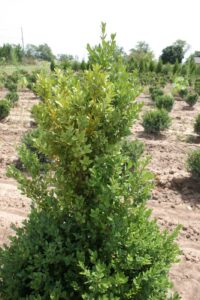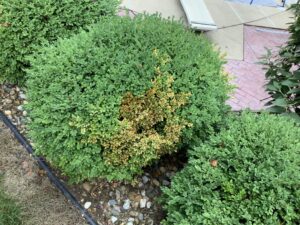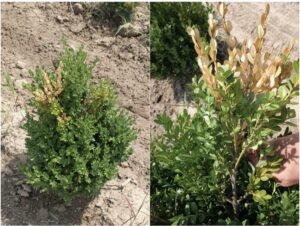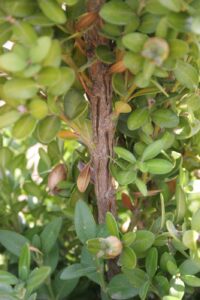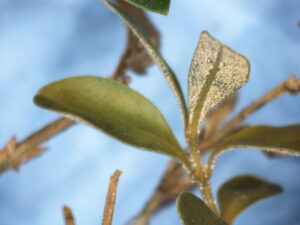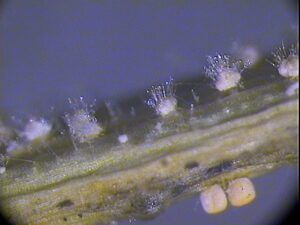One of the most common diseases found on boxwoods is Volutella blight and dieback, caused by the fungi Pseudonectria foliicola and P. buxi. Both fungi are considered weak pathogens, always around but not causing much damage until plants are injured or stressed, rarely infecting otherwise healthy plants. Volutella blight alone usually doesn’t kill boxwoods, but loss of branches can severely affect symmetry and ornamental value. A previous PLR article discusses Volutella blight on pachysandra.
- Figure 1. Boxwood showing stunting and gray green color typical of early stages of Volutella dieback.
- Figure 2. Boxwood with Volutella dieback.
- Figure 3. Dead boxwood stems with a tan to straw color are often associated with Volutella dieback.
Symptoms and signs:
During the growing season, infected branches may show stunted growth that later turns gray-green (Fig. 1) and usually dies by fall or winter (Fig. 2), becoming light tan or straw colored in spring (Fig. 3). A closer examination of stems may show bark splitting (Fig. 4) and/or sunken cankers at the soil line or in the crotches of branches where dead leaves accumulate. Wood under the sunken canker is usually blackened and the bark on blighted stems often becomes loose and falls away, especially on larger branches. The fungus produces clusters of fungal spores which are pink to cream-colored on lower leaf surfaces (Fig 5.). On blighted stems, signs of the fungus appear as cushions of small, salmon-colored spore masses that erupt through the epidermis (Fig. 6). Winter injury causes foliar symptoms similar to those caused by Volutella blight but without signs of fungal infection, and Volutella infection often follows winter or frost injury, leading to confusion about diagnosis. If dieback or bronzing is caused by winter injury alone, the plant should produce new healthy leaves later in spring and eventually hide the damaged leaves.
- Figure 4. Splitting bark on a boxwood stem due to Volutella dieback and/or winter injury.
- Figure 5. Boxwood leaf showing sporulation of a Pseudonectria sp.
- Figure 6. Close view of Pseudonectria sp. sporulation on a boxwood stem.
Management:
- Choose a well-drained planting site
- Maintain plant vigor with moderate fertilization, taking care to avoid fertilizing after mid-summer to ensure good winter dormancy
- Irrigate as needed during dry periods
- Prune out infected branches back to healthy tissue and destroy all pruned material
- Fungicides are not recommended for the control of this disease in the landscape
- There are no resistant boxwoods available.
Other Boxwood Diseases:
Be aware that other disease problems, such as Phytophthora root rot or nematodes, can also cause loss of foliage and dieback symptoms on boxwood. Boxwood leaves that die as a result of Volutella, various root diseases or environmental stresses are frequently colonized by the fungus Macrophoma. This fungus produces numerous black fruiting bodies, which can be seen as dark specks on dead leaves. It is a secondary colonizer of dead leaves and its presence indicates that the plant is stressed by some other factor.
Concerned about possible boxwood blight? See our publication to learn more: http://www.extension.purdue.edu/extmedia/BP/BP-203-W.pdf
